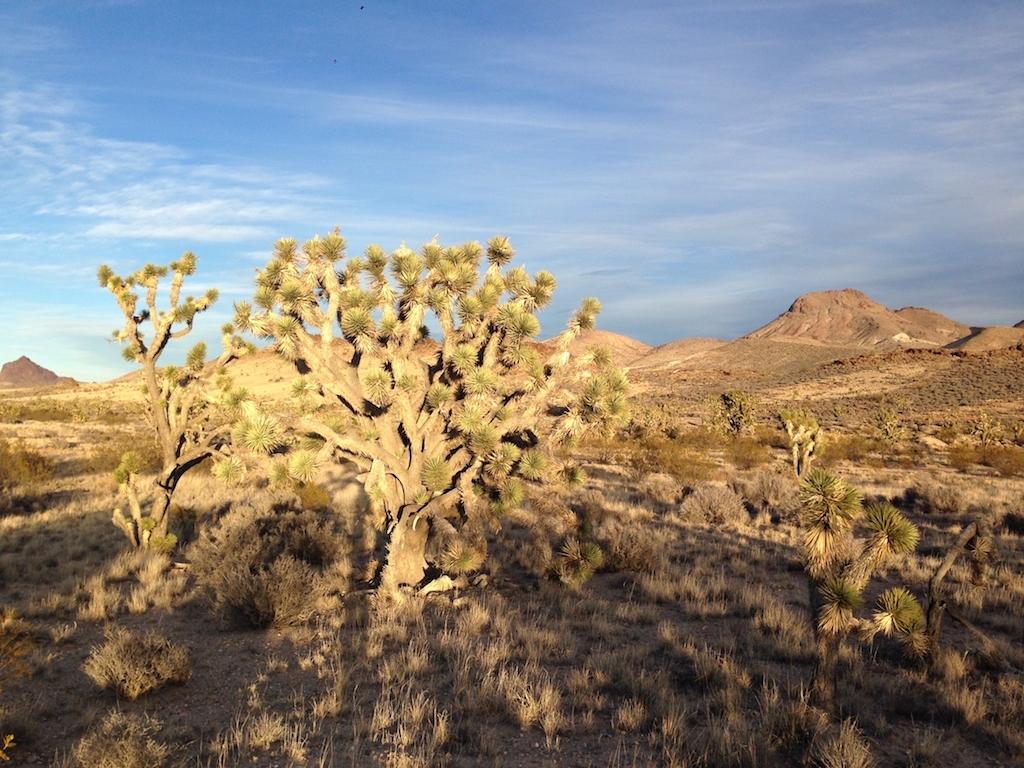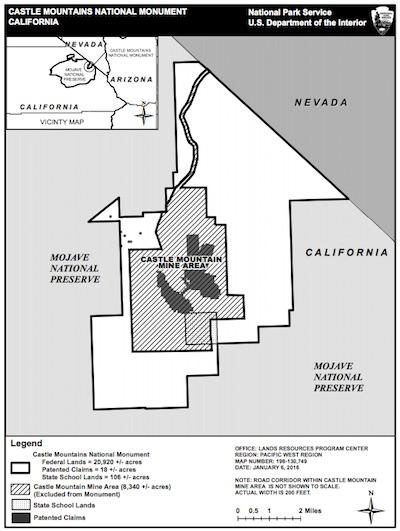
Castle Mountains National Monument will serve as a critical connection between two mountain ranges, protecting water resources, plants, and wildlife such as golden eagles, bighorn sheep, mountain lions, and bobcats/DOI
Most Americans woke up Friday with three new national monuments in the country. Located in California, the three -- Castle Mountains National Monument, Sand to Snow National Monument, and Mojave Trails National Monument -- were all hewn from federal lands and long have been called for by U.S. Sen. Dianne Feinstein.
The monuments are located in San Bernardino and Riverside counties about one hour from the Los Angeles metropolitan area and one hour from the Las Vegas metropolitan area. They protect approximately 1.8 million acres of "spectacular landscapes, fragile wildlife habitat, unique historic resources, and important cultural sites," an Interior Department release said.
The three monuments connect Mojave National Preserve, Joshua Tree National Park, San Bernardino National Forest, and 15 wilderness areas previously designated by Congress, creating a series of protected lands stretching hundreds of miles. They all protect current uses of the land, including military training operations, off-highway vehicle recreation, transportation, utility corridors, and existing mining operations, the release said.
One of the three, the nearly 21,000-acre Castle Mountains National Monument, will be managed by the National Park Service. The other two will be under the care of either the Bureau of Land Management or U.S. Forest Service, or both.
Castle Mountains is surrounded on three sides by the Mojave National Preserve. Its boundaries include approximately 106 acres of land owned by the State of California, and approximately 18 acres of privately owned lands, but the non-federal lands within the boundaries would not be part of the monument unless and until subsequently acquired by the federal government, Interior officials said.
The area generally may not be disposed of by the United States and is closed to new extractive uses such as mining and oil and gas development, but the designation is subject to valid existing rights. The National Park Service shall work with State officials to ensure the availability of water resources, including groundwater, needed for monument purposes. The proclamation does not enlarge or diminish the State’s jurisdiction with respect to fish and wildlife, or the rights of Indian tribes, nor does the proclamation restrict or preclude military overflights. Hunting is not authorized under applicable park law.
Back in October senior Obama Administration officials visited Palm Springs, California, at the Sen. Feinstein’s invitation to hear from the community about its vision for conservation in the California desert. Supporters of protecting these areas include local counties and cities, area business groups, tribes, hunters, anglers, faith-based organizations, recreationists, local land trusts and conservation groups, and students from local schools, the release said.
The Castle Mountains National Monument is an integral piece of the Mojave Desert. The area has important flora, fauna, water, and historic resources, and its designation as a national monument helps to preserve related resources set aside for protection in the Mojave National Preserve. According to the release, the monument has some of the finest Joshua tree forest and native desert grassland in the Mojave Desert and contains important cultural resources, including Native American archaeological sites and vestiges of mining, ranching, and the railroad from the period of Western expansion.

The new monument is surrounded on three sides by Mojave National Preserve/NPS
“The California desert is a cherished and irreplaceable resource for the people of southern California,” said Interior Secretary Sally Jewell in a prepared statement. “It is an oasis of nature’s quiet beauty just outside two of our nation’s largest metropolitan areas. Its historic and cultural resources tell the stories of armies, travelers, ranchers, and miners, and of the original caretakers of this land. Today’s designation by the President furthers the longstanding work of public land managers and local communities to ensure these areas will remain preserved and accessible to the public for future generations.”
The designation proclamations direct the agencies to engage the public in comprehensive planning for the management of these areas, building upon the provisions outlined in the proclamations. The three designations all honor valid existing rights, and provide for continued use for training activities of the U.S. military.
* The Sand to Snow National Monument encompasses approximately 154,000 acres of federal lands, including just over 100,000 acres of already Congressionally-designated wilderness, east of Los Angeles, California, and will be managed jointly by the U.S. Forest Service and the Bureau of Land Management. Rising from the floor of the Sonoran Desert to San Gorgonio Peak, the tallest in southern California, the monument includes lush desert oases, significant archeological sites, and thirty miles of the world-famous Pacific Crest Trail. The area is a favorite for camping, hiking, hunting, horseback riding, photography, wildlife viewing, and even skiing. The area is renowned for its rich diversity of rare and fragile wildlife and is one of the most biodiverse areas in southern California.
* The Mojave Trails National Monument spans 1.6 million acres of federal lands, including more than 350,000 acres of already Congressionally-designated wilderness, managed by the Bureau of Land Management between Barstow and Needles, California. It is a stunning mosaic of rugged mountain ranges, ancient lava flows, and spectacular sand dunes. The monument contains the longest remaining undeveloped stretch of Route 66 and some of the best preserved sites from the World War II-era Desert Training Center. Connecting the Mojave National Preserve with Joshua Tree National Park, the Mojave Trails National Monument ensures the biological connectivity of this landscape while preserving traditional uses such hunting and off-highway vehicle recreation.
The announcement brings to 22 the number of national monuments established by President Obama under the Antiquities Act, an authority exercised by 16 presidents starting with President Theodore Roosevelt in 1906 and used to protect treasures such as the Grand Canyon, the Statue of Liberty, and Colorado’s Canyons of the Ancients. Altogether, President Obama has protected more than 265 million acres of public lands and waters – more than any other President – and has preserved sites that help tell the story of significant people and extraordinary events in American history.



Comments
Good news.
Castle Mountains should probably merge with Mojave NPRES somewhere in the future.
Now we need two in Utah. Bears Ears and the Canyonlands National Monuments.
Let's continue to create "pay to enter" sites so fewer minorities are able to visit. The antiquities act is becoming an elitist adventure that further separates the haves and the have nots. Think I am mistaken? Visit any national monument in the west and see how many African Americans are visiting.
Mojave National Preserve is not 'pay to enter'. I'm pretty sure the new Monuments won't be either. In fact, you can visit Death Valley National Park and Joshua Tree National Park without paying, if you enter and exit via certain roads. If people want to visit these places but don't, it probably has to to do with not having a reliable car, money for gas for the car, the possibility to get off work, or, in most cases, lack of interest.
But, Mo, could that be due to other factors and not just fees? Has anyone asked our African American neighbors about it?
And think it's bad now? Just wait until public lands are "returned" to the western states and all that land is sold to private owners.
Since noone is proposing that, its unlikely.
Since "pay to enter" fees are a miniscule piece of the cost of visiting a western park, I don't think they have anything to do with attendance - whether while, black, yellow or green.
I agree with ecbuck(!) and politely disagree with Mo Bettah: entrance fees are at most a tiny impediment.
Also, BLM was already looking to manage a swath of their lands between Death Valley, Mojave Preserve, and down to Joshua Tree, as some form of conservation corridor. Not closed to vehicles like wilderness, but not open to mining, solar development, and other uses. I haven't heard if or how this designation impacts that management planning.
But if Rep. Noone's proposals go through, it will. Although as you say, it's unlikely.